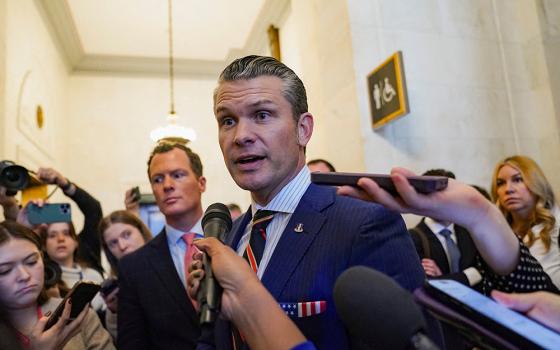Cardinal Raymond Burke has reportedly expressed his profound sorrow that “the failure of knowledge and application of the canon law … contributed significantly to the scandal of the sexual abuse of minors by the clergy in some parts of the world.”
His remarks, as far as they go, reveal a serious misunderstanding of the deeper nature of the clergy sex abuse crisis. Not to face its larger and, in the eyes of many, more troubling dimension, is to make it all the more unlikely we will ever get beyond it.
What makes the cardinal’s seemingly inadequate analysis all the more shocking is that he holds a critical position of authority within our church. As head of our church’s highest court, the Supreme Tribunal of the Apostolic Signatura, any inability – or unwillingness – to face, examine and respond to the scandal, now over a quarter century old, only adds to the crisis and feeds an already widespread pessimism that our church leaders are not up to the task.
Is it personality or structure? Is it the makeup of the leadership or the way that leadership carries out (or fails to carry out) its duties?
What is especially bothersome about Burke’s inadequate analysis of the abuse scandal is it comes after decades of news coverage and studies, civil and ecclesial, which suggest far larger institutional challenges than wayward priests who have failed to live by canon law.
To start with let’s note here the obvious: preying sexually on children violates much more than canon law. More fundamentally it violates God’s laws and every notion of decent human conduct in cultures throughout the world. As one NCR commentator recently wrote: It violates “the laws of the heart and soul, laws of human love, consensual adult expressions of that love, secular laws, criminal laws, and every other law--even if canon law never existed.”
Now, to the next level. What the cardinal fails to mention in his assessment of the scandal is that from the very beginning it has been a two-step violation against the Catholic family. The first has been the abusive acts by the priest; the second has been a consistent pattern of episcopal denial and cover-up. This second violation has been especially troubling, as it has revealed a generation of episcopal leaders more concerned about institutional image than gospel witness.
At NCR we first began reporting the sex abuse scandal at in 1985 and for some 15 years we were often quite alone in the vigil. However, it only took us several weeks of investigation early on to see the twofold dimension of the scandal, widespread sexual offenses and an equally widespread pattern of institutional cover-up.
From the start, we could see that in diocese after diocese priests who had been preying on the young were being protected by their bishops. It was shocking to see such denial. It was a pattern that sent not one but two destructive daggers into the souls of the victims who had first been abused and then later termed deceitful liars by major church authority figures. We could hardly believe so many bishops, acting independently, it seemed, would throw children under the proverbial bus to protect their fellow clerics.
At the beginning, especially in the 1980s and 1990s, parents were often reluctant to take on their church. Civil law suits were almost always a last resort. The parents of abused children would first approach their bishops believing their cases would be heard and acted upon in a compassionate way. But in case after case, they were soon disillusioned. They would find their bishop would deny the accusation and question the veracity of the child. In case after case the bishops would respond not with pastoral care but by surrounding themselves with attorneys would we be called in to protect the institution.
In case after case, the pattern would be the same. The bishop would side with the priest. When evidence against the priest mounted, often as more than one victim appeared before the bishop, he would cover up the priests actions and wound not bring these crimes to the attention of civil authorities. It was always thought this was a “family” problem.
But it was a “problem” that would only grow as the priests, often shuffled to new parishes, sometimes after treatment, sometimes not, would go on to abuse more children.
In the first decades of abuse reporting parents of aggrieved children would hire attorneys as a last resort. As news of these civil cases grew more widespread, many adult Catholics would have flashbacks, recalling sexual abuse they had suffered as children, often at the hands of clergy. These Catholics filed more suits. Once inside the legal networks, pastoral responses were almost impossible, not that they were ever the preferred manner of handling the abuse issues.
BishopAccountability.org, an archival website established by lay Catholics to keep track of clergy sex abuse cases reports that over 3,000 civil lawsuits have been filed against the church.
The patterns of abuse and cover-up have not been limited to the United States. They have, of course, been reported worldwide. The only nations in which Catholic clergy sex abuse has not become public are those lacking a relatively free press and relatively free judicial system. The media and courts have been shown to be the only two institutional forces of accountability the aggrieved have had at their disposal – short of any reluctant to absent efforts by the institutional church.
Cardinal Burke would do us all a favor to examine the second component of the clergy sex abuse scandal, that component that deals with his episcopal colleagues. He might ask why canon law has not come to the aid of the children in a forthright and active manner. He might ask how church law has allowed his fellow bishops to cover up the scandal rather than bringing to public. He might examine how church law has played a role in driving many Catholics, disaffected by the scandal, from the church.
It has been the collective failure by our church leaders – a failure lasting to this day – that is so disturbing to so many. It has been a failure to adequately address the episcopal complicity and cover up in the quarter century old scandal. This absence of accountability was evident in the June 2002 declaration by the U.S. bishops of their “zero tolerance” law for priests. At that time, the bishops promulgated a Charter for the Protection of Children and Young People. It pledged the Catholic Church in the U.S. to providing a "safe environment" for all children in church-sponsored activities. But the documents said virtually nothing at the time about the episcopal patterns of abusive behavior that allowed the scandal to flourish for so many years.
It held no bishop accountable.
Had church law been effective in protecting Catholic children, it would have required arguably hundreds of bishops to be removed from office. To the contrary, church canons have been woefully ineffective in the eyes of many Catholics in upholding justice, to say nothing of compassion, within our church.
That the prelate who holds the highest position in our church as adjudicator of justice does not address the full dimension of the scandal is sad evidence we remain lost in the wilderness of disillusionment.




